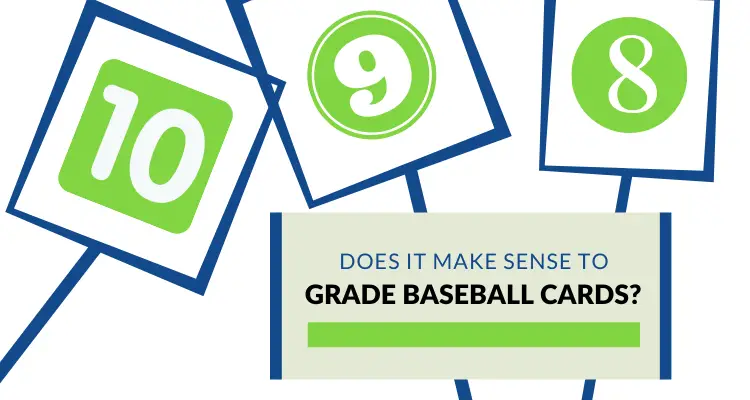 Ryan Barone (@ballcardgenius on TikTok, Card Expert) is a lifelong member of the hobby. He has been quoted in PSA Magazine, and his content has regularly been mentioned in “Quick Rips” (the Topps RIPPED Newsletter) and across other hobby publications. Join his 8,600 followers on TikTok! hello@ballcardgenius.com; Last Time Ago LLC dba Ballcard Genius.
Ryan Barone (@ballcardgenius on TikTok, Card Expert) is a lifelong member of the hobby. He has been quoted in PSA Magazine, and his content has regularly been mentioned in “Quick Rips” (the Topps RIPPED Newsletter) and across other hobby publications. Join his 8,600 followers on TikTok! hello@ballcardgenius.com; Last Time Ago LLC dba Ballcard Genius.
Affiliate Disclosure: This post contains affiliate links. As I am a part of the eBay Partner Network and other programs, if you follow these links and make a purchase, I’ll receive commission. As an Amazon Associate, I earn from qualifying purchases.
Even when you might feel safe with a graded and authenticated card, you should always have your examining eyes and ears on to ensure everything is on the up and up.
Here are a few things to check for when it comes to identifying fake PSA labels and slabs. This is not exhaustive by any means nor is it a 100% foolproof way to determine authenticity.
1. Check for Frosting
The presence of “frosting” could be one sign that the holder slab has been tampered with. PSA describes this as a “cloudy appearance” along the edges.
2. Check for Cracks
This might sound obvious, but it’s more along the lines of looking hard for minor cracks in addition to your once-over for anything major. To take a step back, the PSA case is said to have a strong weld to bring together the front and rear slabs. Thus, when the weld is broken, you might be able to see small fractures. Here is a GIF from PSA:

3. Check the Lighthouse Logos/Holograms
One thing you might see with fake PSA labels is that all of the correct elements might be present on the label, but they might be printed on rather than being the true security elements.
Read More: Fake Michael Jordan Rookie Cards in Heavy Circulation
Meaning, it might look like the lighthouse logo is present, but it’s really just an image that has been printed and not the true logo that reacts to light. Thus, simply hold the slab in light to notice the true “on/off” effect.

PSA features proprietary lighthouse logo technology (which is “virtually impossible to replicate”) that creates an “on/off” appearance when presented to light. This is said to offer a visible “beacon” that is used to let collectors know whether or not the slab is indeed authentic.
As you can see in the image above, there is the lighthouse logo in the center, but also the mention of the “classic” PSA red trim. Also, within the red trim borders is what is called “fugitive ink” that fills the white background. (It is that “wave-like” pattern.)
This fugitive ink (which also helps present check washing) will dissolve when it’s exposed to cleaning chemicals. Thus, if someone were to try and preserve the label but perhaps change the actual label text and contents – I’m guessing – the fugitive ink would wash away.
In the featured video above, PSA mentions that this thus makes tampering with the label’s variable print a “useless pursuit.”
A strip of tamper-evident fugitive ink rests below the blue background. (Tamper-evident simply means that tampering with the holder will be evidenced by measures in place.)
4. Read the Front Label from the Back
PSA also mentions that an authentic PSA label should be somewhat visible when holding the card up to light at close-range, looking through the back of the label.

As you can see in my example, you can’t see every single letter, but you can definitely make out most of the wording. The idea here is that another label is placed on top of the authentic label, it might make seeing through from the back much tougher. Thus, you’ll also want to ensure the label you’re seeing is in fact tha label presented on the front.
5. Check Slab Flexibility
Part of the benefit of PSA’s “sonic weld” is that it creates a firm and not very bendable slab holder. If the weld is broken, though, the holder becomes much more flexible. In handling my personal slabs I have on hand, there is very little to no give at all when attempting to bend even at the slightest.
All of this considered, when a deal is too good to be true, it often is. I can’t tell you the amount of times a “great deal” quickly evaporated simply by me taking extra time to examine the situation, ask questions, and be all around cautious.
This is also why out of all the places to buy cards, I typically like to use sites like COMC where there is an intermediary between the buyer and the seller. It just adds a level of comfort in knowing that the seller had to go through the time to send the card to COMC where they knew it was going to be examined versus just listing it on eBay themselves without any 3rd-party involvement.
The new eBay vault, though, can offer the same piece of mind given high-value cards must first pass an authenticity check before payment is released to the seller and before the card is forwarded to the buyer.



